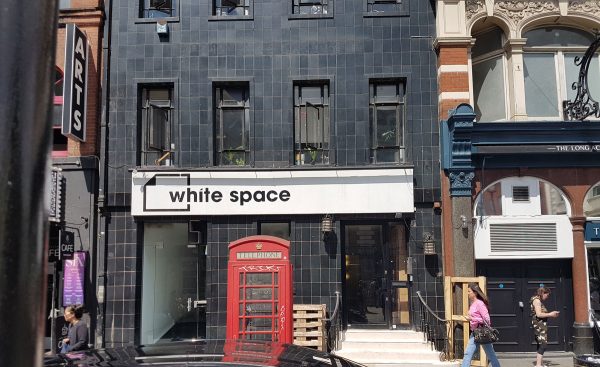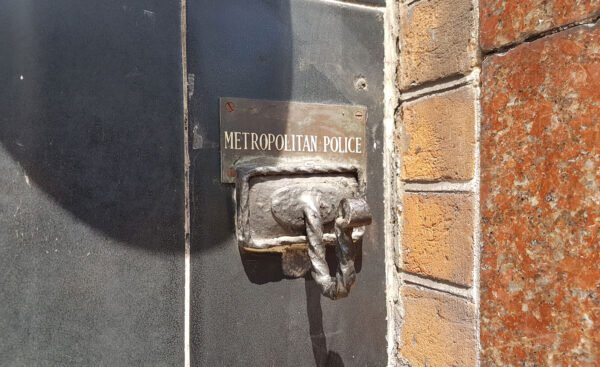A building near Leicester Square is famous for one small thing that is pointed out by every tour guide who passes it. Can you see it?
Yes, there in the corner under the lamp — the hook — the policeman’s hook that is widely claimed to be for traffic police to hang up their heavy cloaks.
The story varies a bit, but the crux of it is that traffic police used to wear big heavy cloaks, and on hot days wanted to remove them. A building next to a busy road junction was being built, so they used a convenient nail that was sticking out to hang their coat up, but when the building was finished, the nail was gone.
The police or the building owners then put up a replacement coat hook for them, and it’s still there today.
Is it true?
Well, there’s a total absence of any definitive evidence either way, but let’s pick the story apart and see what we conclude.
Most stories suggest this all took place in the 1930s when the building was under construction – but this very modern-looking building is older than that. Much, much older. It’s a rare survivor in this part of London of a building that dates from the 17th century, and we certainly didn’t have road traffic police back then.
Despite the modern exterior, there is still quite a bit of heritage left inside, such as the original 17th-century staircase, and 19th-century decorations. A plan to demolish the two buildings next door (with the facade preserved) for a new hotel and underground theatre will see 4/5 Great Newport Street’s interior restored as part of the hotel.
The black tiles were added to the frontage of the building at a more recent date – and that recladding might accord with the stories of the nail during building works.
There’s a slight problem with the date that happened though – while most stories about the coat hook say the construction work took place in the 1930s, and indeed some planning documents say the black tiles were added in the 1930s, the black tiles weren’t added until the mid-1940s, at the earliest.
Take a look at this photo of the building in 1943, and you will notice the absence of any black tiles. Or a policeman’s hook.
The other problem is the sign, the font is wrong for a Met Police sign. Some examples of the fonts used by the Met Police down the years.
1924 – Metropolitan Police Traffic Regulations
1938 – Demonstration book of Metropolitan Police
1950s – Sign on building (close, but no cigar)
It is possible that the building owner bought a fake tourist type sign and used that rather than having one commissioned, but it’s difficult to see the Met Police permitting that to happen.
What do I conclude.
Well, we know that the building was not clad in tiles and that the hook was not added until at least 1944 at the very earliest.
While police still controlled the traffic in places, by the 1930s traffic lights were starting to become commonplace in the UK. So it’s unlikely that a policeman would have been directing traffic at a major road junction in the 1930s, and certainly not in the late 1940s.
Also there’s the practical issue of the fact that the coat hook is a good distance from where the traffic police would be standing, and that leaves the risk of the coat being stolen.
I’ve been utterly unable to trace when the hook appeared, but it’s instructive that no reports about the hook appear before about a decade ago, and there’s no record of it in older tourist guides of the area. There is also no reference to the hook in the heritage statement for the planning applications, which if it were that old, would be an odd omission. I can also find no reference to it being conserved in any other planning applications affecting the frontage of the building going back a couple of decades. I would have expected at least a sentence somewhere.
I suspect what happened is that some wag added the hook in the past decade or so, and somehow, a bit like the noses of soho, a mythic tale has grown up around the hook.
Quite these myths emerge is something I find even more fascinating, as someone evidently invented the story, and with variants, it’s been repeated in so many places ever since. How did the story come to be, and how have so many publications and tour guides picked up on it in so short a period of time?
To the future though, there was a plan to remove the black tiles and restore the frontage to its 19th-century appearance. However, investigations found that could end up doing more harm than good, so the developer proposes to clean up the frontage, keeping the tiles intact.
And presumably, retaining the coat hook to delight tourists for years to come.
As an aside, I used to work in retail, and whenever taking over a store would let local police on patrol know that they were welcome to use the kitchen and toilets. The police had a facility to use, the staff had gossip to hear, and frankly, it helped the shop to deter thieves if it was known to be a police stop point.
One time I was running an off-license in Windsor right by the castle when a state visit occurred, and it was supposed to be a cold day but turned out warm. So lots of police who were drafted in to help out dropped their coats off in the basement of the off-license and used the kitchen for breaks.
It was also the day my area manager decided to pay a surprise visit, but she got the bigger surprise when she went downstairs and was confronted by the sight of a dozen coppers sat on boxes of wine drinking cups of tea.












Better than them sitting on boxes of tea drinking wine!
The Met were still doing routine point duty very late on, into the early 70s. My mother was a bus conductor for LT, her brother was a Met copper. One day c.1970 she found her bus stuck in a massive jam a good mile or more outside Kingston town centre. “I bet they put my brother on point duty today”, she joked to her driver. They had.
I’m fairly certain I’ve been in that building a few times 20 or so years ago and the hook was never pointed out to me, if it was there then.
great article… thanks for sharing… 🙂
Yes – how do these myths arise? My favourite, which I unpicked some years ago, is the naming of the grand Crocker’s Folly pub in Aberdeen Place, NW8, built in 1898-9 and then called the Crown Hotel. Well, the promoter, Frank Crocker, understood that the Great Central Railway, which was then completing construction, would have its terminus near his pub-cum-hotel which would be great for business. Unfortunately it didn’t and ended up a mile away at Marylebone. Ruin, disaster, despair, so he committed suicide by jumping from an upstairs window of his fine new premises. A tragic tale were it true. In fact the route had received Parliamentary assent in 1893 and the first trains steamed into Marylebone in 1898. Mr C, in fact, died a natural death but at the young age of 41 in 1904. The pub was rechristened Crocker’s Folly in 1987 the new name presumably reflected a somewhat older tale but when this originated I have never discovered. But let’s not allow facts to disturb a lurid tale!
Hopefully I can add some more detail to this story, most of which is true. My grandfather, who recently passed away, told me about this hook. He was in the Met Traffic division in the late 40s/early 50s and there was indeed a large nail to hang their cloaks on. Him and his colleague stopped a surveyor who was eyeing up the nail. It transpires the surveyor was working for Pitman Publishing who owned the building as they were looking to refurbish after bomb damage. My grandfather suggested to the surveyor that if the nail was removed it would be reported as criminal damage to police property! When he next saw the building after the refit (including all the black brick work), the hook as still seen today was in place (originally it was gold-gilted and the Metropolitan Police part was in blue and white enamel). This explains why it wasn’t in official Met Police font.
Those black tiles look knackered to me. How they’re going to clean them up I cannot imagine – they look like it’ll take sand blasting to even them out but that probably would change their finish entirely.
Ian,
I have the definitive story about the coat hook if you require it.